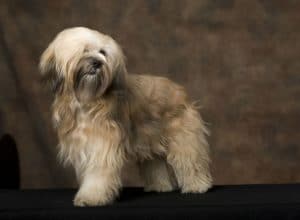The Winner of Crufts 2007 – The Tibetan Terrier
 As its name suggests, the Tibetan Terrier originated in Tibet. It’s one of the oldest breeds of dog. The original owners of these dogs were Tibetan monks. These monks lived high in the Himalayas and cherished the dogs that lived with them. Thought to be good luck charms, these dogs were never sold. Instead, they were given as gifts to esteemed visitors of the mountain. Because they were thought to be carriers of good luck, these dogs were never abused or mistreated for fear of supernatural retribution.
As its name suggests, the Tibetan Terrier originated in Tibet. It’s one of the oldest breeds of dog. The original owners of these dogs were Tibetan monks. These monks lived high in the Himalayas and cherished the dogs that lived with them. Thought to be good luck charms, these dogs were never sold. Instead, they were given as gifts to esteemed visitors of the mountain. Because they were thought to be carriers of good luck, these dogs were never abused or mistreated for fear of supernatural retribution.
The breed made its way to Europe through an English doctor in the early 20th century. This doctor was working in India and was gifted with two Tibetan Terriers. The first was from a patient whose life she saved; the second was from the Dalai Lama himself. These two dogs were bred and their offspring were brought back to England. From there the breed spread throughout Europe and to North America. Today they are a beloved family pet and a strong competitor in agility and obedience competitions.
The Tibetan Terrier is a compact dog with a square build. He stands between 35 and 41 centimetres and weighs between 9.5 and 11 kilograms. He has large, dark eyes, droopy ears, and a feathered, curled tail. His feet are flat and webbed, almost as though he was made with built-in snow shoes!
With this breed, the main event is the coat. The Tibetan Terrier has a luxurious double coat that causes him to bear a striking resemblance to the head of a mop. Instead of fur, the coat is made up of hair and can come in any colour and pattern. As you can imagine, grooming is a big task for this little dog. A thorough brushing two or three times a week is recommended to avoid matting. This breed does not shed; instead, hair will drop out a little at a time much like a human’s. If the dog is not being kept for shows, his coat can be clipped short to keep him cool during the summer.
 The Tibetan Terrier is a sweet, gentle and lively dog. He will play nicely with children and be reserved but respectful of strangers. You’ll want to make sure that he gets plenty of exercise – even though he is small he’s still a bundle of energy.
The Tibetan Terrier is a sweet, gentle and lively dog. He will play nicely with children and be reserved but respectful of strangers. You’ll want to make sure that he gets plenty of exercise – even though he is small he’s still a bundle of energy.
Tibetans love to bark. They’re not yappy; rather their bark is deep and assertive. While this can serve as a great warning if someone is prowling around your home uninvited, constant barking can be a bit of an annoyance. Therefore it is important to train this breed from a young age about when it is and is not appropriate to use their voices. Thankfully, this breed is very intelligent, making training easy. Early training is also useful to prevent shyness, as this breed does tend to be reserved around strangers.
Tibetan Terriers suffer very few health problems. They are sensitive to fleas and may have problems with hip dysplasia. They have a relatively long life span, and can be expected to live between 12 and 15 years.
When given proper socialization, Tibetans usually get along very well with other animals. If not trained well, they may try to dominate other dogs. Sweet natured and energetic, this breed would make a wonderful pet – just make sure you have time for grooming!


